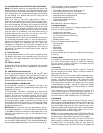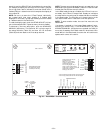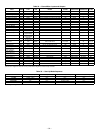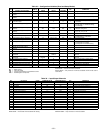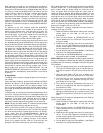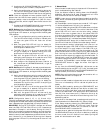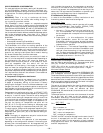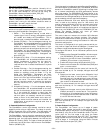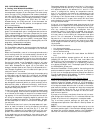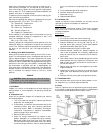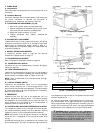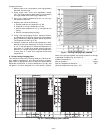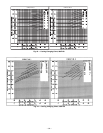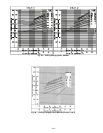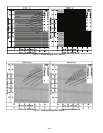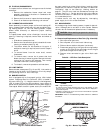
—60—
XVIII. OPERATING SEQUENCE
A. Cooling, Units Without EconoMi$er+
When thermostat calls for cooling, terminals G and Y1 and
the compressor contactor (C) are energized. The indoor (evap-
orator) fan motor (IFM), compressor, and outdoor (condenser)
fan motor (OFM) start. The OFM runs continuously while the
unit is in cooling. When the thermostat is satisfied, C is deen-
ergized and the compressor and OFM shut off. After a
30-second delay, the (IFM) shuts off. If the thermostat fan
selector switch is in the ON position, the evaporator motor
will run continuously.
B. Heating, Units Without EconoMi$er+
When the thermostat calls for heating, terminal W1 is ener-
gized. The induced-draft motor is energized and the burner
ignition sequence begins. The indoor (evaporator) fan motor
(IFM) is energized 45 seconds after a flame is ignited. When
additional heat is needed, W2 is energized and the high-fire
solenoid on the main gas valve (MGV) is energized. When
the thermostat is satisfied and W1 is deenergized, the IFM
stops after a 45-second time-off delay.
C. Cooling, Units With EconoMi$er+
For EconoMi$er+ operation, there must be a thermostat call
for the fan (G). This will move the damper to its minimum
position.
When the EconoMi$er+ control is the occupied mode and a
call for cooling exists (Y1 on the thermostat), the control will
first check for indoor fan operation. If the fan is not on, then
cooling will not be activated. If the fan is on, then the control
will open the EconoMi$er+ damper to the minimum position.
On the initial power to the EconoMi$er+ board, it will take
the damper up to 2
1
/
2
minutes before it begins to position
itself. With subsequent fan signal (G) to the board, the
change in damper position will take up to 30 seconds to ini-
tiate. Damper movement from full closed to full open (or vice
versa) will take 2
1
/
2
minutes.
If the damper is in the process of a change (for example going
to 100% open) and the signal (G) is turned off, the damper
will continue to open to 100% before it closes (due to no fan
signal [G]).
If free cooling can be used as determined from the appropri-
ate changeover command (switch, dry bulb, enthalpy curve,
differential dry bulb, or differential enthalpy), then the con-
trol will modulate the dampers open to main the supply air
temperature set point plus 2° F.
If there is a further demand for cooling (cooling second stage
— Y2 is energized), then the control set point for the leaving
air will be set at the supply air set point to increase the cool-
ing capacity. If this cannot satisfy the load then the control
will bring on compressor stages as needed to maintain the
supply air temperature set point. The EconoMi$er+ damper
will be locked open at 100% or the maximum damper posi-
tion set point.
To ensure that there is oil return, the compressors will oper-
ate for at least 3 minutes. If, during this period, the leaving
temperature drops below the set point by 5° F, then the
EconoMi$er+ dampers will be closed to 60% until the com-
pressor is turned off to avoid cold leaving air temperatures.
If the conditions are not suitable for free cooling then the
EconoMi$er+ dampers will be closed to the minimum venti-
lation position.
Compressor stages will be used to cool the air. If the control
is configured for direct control by Y1 and Y2, then the stages
will sequence based on the demand of Y1 and Y2. If the
control is configured for leaving air temperature control,
then Y1 will maintain the leaving air temperature at the
supply air set point plus 2° F. If Y1 and Y2 are closed, then
the leaving air will be controlled to the supply air set point.
If Y2 is closed and Y1 is open, then control will shut down
and indicate an error due to a thermostat failure or improper
wiring of the thermostat.
If the unit is in the unoccupied mode, then the control of the
temperature will depend on the unoccupied free cooling con-
figuration: no unoccupied cooling, unoccupied free cooling
with any mechanical cooling, or unoccupied free and
mechanical cooling. If free cooling is enabled, then the con-
trol will check if free cooling can be used. The EconoMi$er+
will then control to the leaving air temperature set point
plus 2° F for a Y1 command, or the leaving air temperature
set point for a Y1 and Y2 command. If mechanical cooling is
allowed to be used, then the control will then bring on addi-
tional stages of mechanical cooling if free cooling cannot sat-
isfy the load.
If the EconoMi$er+ control:
• is in the occupied mode
• is configured to use demand ventilation
• cannot use free cooling
• has return air or space CO
2
levels below the DAQLO
limit,
then the EconoMi$er+ damper position will be set to the
IAQMIN_SP set point. If the CO
2
level rises above the
DAQLO limit, then the dampers will modulate open in a lin-
ear relationship until the return air or space CO
2
levels are
at or above the DAQHI limit. The damper position will be at
the ECONOMIN_SP set point.
When the EconoMi$er+ is being used for free cooling and the
position exceeds the power exhaust set point, then the con-
trol will turn on the appropriate power exhaust fans. Refer to
Fig. 23 for barometric relief capacity, Fig. 24 for outdoor air
leakage, and Fig. 25 for pressure drop.
Unoccupied and Occupied Minimum Position Control
There is an unoccupied minimum damper position and an
occupied minimum damper position on the EconoMi$er+
controller. When the HVAC fan is off the outdoor air damper
will always be closed. When the fan is on and in the unoccu-
pied mode, the outdoor air damper will be at the unoccupied
minimum position. When the fan is on (G call) and in the
occupied mode, the outdoor air damper will be at the occu-
pied minimum position.
A jumper wire is factory-installed to force the unit into occu-
pied configuration whenever G or Y1 are closed. Without the
jumper wire, the unit will always be in unoccupied mode.
The 2 minimum position settings are also used in the
IAQ sequence of operation. See Indoor Air Quality Sensor on
page 21.
NOTE: The minimum position signal takes priority over the
maximum position signal. If the maximum damper position is
set below the minimum damper position, the EconoMi$er+
controller will maintain the actuator at minimum position.



